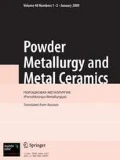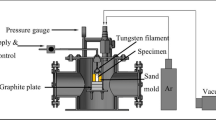Conclusions
-
1.
Tungsten disilicide possesses comparatively high resistance to oxidation by oxygen over the temparature range 700–1200‡C. Its oxidation resistance is less than that of MoSi2 but substantially exceeds that of W2B5.
-
2.
The kinetic curves of high-temperature oxidation of WSi2 have undulations due to cracking and subsequent self-healing of scale.
-
3.
In spite of the complex character of the reaction of oxidation of WSi2 it may be assumed that to an approximation the oxidation rate of the silicide at all the temperatures investigated obeys a parabolic law.
-
4.
The oxidation rate of WSi2 is virtually independent of oxygen pressure (in the range 1–740 torr) during the first 90 minutes' exposure, and it is only at longer process times that some differences become evident.
-
5.
It was found that at temperatures of up to 900‡C the scale on WSi2 consists of W3O, WO3, and SiO2, while at higher temperatures it contains tungsten silicate and lower tungsten oxides as well as the above-mentioned phases.
Similar content being viewed by others
Literature cited
R. Kieffer, F. Benesovsky, and E. Gallistl, Z. Metallk.,43, 284 (1952).
V. E. Ivanov et al., Izv. Akad. Nauk SSSR, Neorgan. Mat.,1, 1360 (1965).
A. N. Efimenko et al., Fiz. Metal, i Metalloved.,16, 931 (1963).
G. V. Samsonov, Silicides and Their Technical Applications [in Russian], Izd. Akad. Nauk USSR, Kiev (1959), p. 94.
L. A. Glebov, V. A. Lavrenko, and V. M. Timoshenko, Zh. Fiz. Khim.,46, 2138 (1972).
R. Kieffer and E. Cerwenka, Z. Metallk.,43, 101 (1952).
E. Scheil, Z. Metallk.,29, 209 (1937).
E. A. Gulbransen and K. F. Andrew, J. Electrochem. Soc.,107, 619 (1960).
G. A. Meerson, Zh. Russk. Fiz.-Khim. Obshchestva,60 (1928).
V. P. Elyutin, Yu. A. Pavlov, et al., Izv. Vysshikh Uchebn. Zavedenii, Chernaya Met.,7, 12 (1961).
R. F. Voitovich, Refractory Compounds: Thermodynamic Characteristics [in Russian], Naukova Dumka, Kiev (1971).
R. P. Ozerov, Usp. Khim.,24, 951 (1955).
G. HÄgg and N. Schönberg, Acta Cryst.,7, 351 (1954).
Author information
Authors and Affiliations
Additional information
Translated from Poroshkovaya Metallurgiya, No. 3 (135), pp. 77–81, March, 1974.



